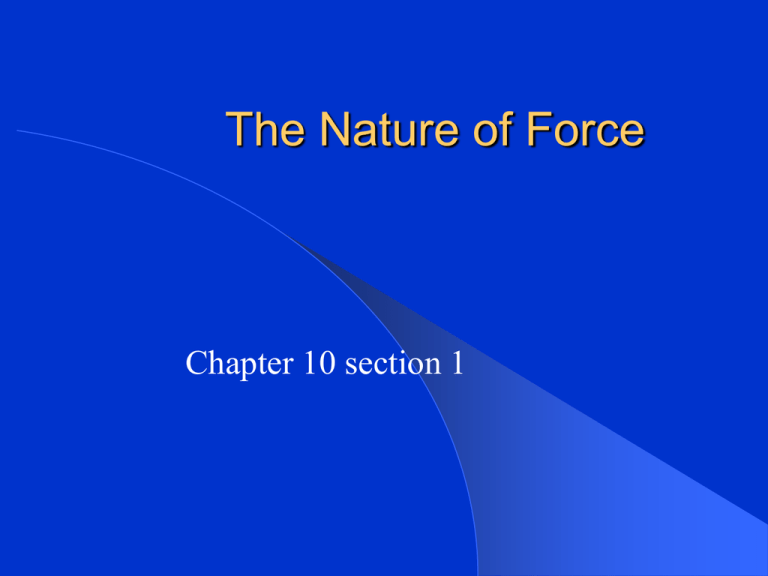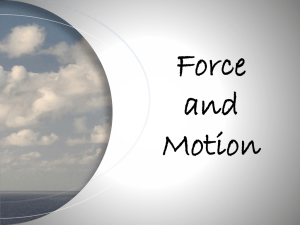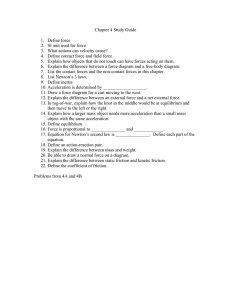The Nature of Force Chapter 10 section 1
advertisement

The Nature of Force Chapter 10 section 1 What is a force Force is a push or pull. Forces are either balanced or unbalanced. Unbalanced Forces Can cause an object to start moving, stop moving, or change direction. Unbalanced forces acting on an object will change the object’s motion. When 2 forces act in the same direction they add together. When 2 forces act in opposite directions they add together however one number is positive and one is negative. When 2 equal forces act in opposite directions the object stays put. What is the net force? The net force is the overall force after all the forces are added together. When there is a net force acting on an object the forces are unbalanced. Balanced Forces Equal forces acting on one object in opposite directions are called balanced forces. Balanced forces acting on an object will not change the objects motion. Newton’s First Law of Motion An object at rest will remain at rest and an object moving at a constant velocity will continue moving at a constant velocity unless acted upon by an unbalanced force. Inertia INERTIA is the tendency of an object to resist change in motion. Example: when the car stops suddenly and you continue to move forward. Mass Mass is the amount of matter in an object. SI unit is the kilogram. The amount of inertia an object has depends on its mass. The greater the mass the greater the inertia. Force, Mass, and Acceleration 10 - 2 Newton’s nd 2 Law of Motion The net force on an object is equal to the product of its acceleration and its mass. Force = Mass x Acceleration Sometimes people refer to the equation as Newton’s 2nd Law. Units of measurement One Newton = 1 kg x m/s/s Force = ma Acceleration = f/m Changes in force and mass How can you increase the acceleration of the wheel barrel? Increase Force Decrease Mass Friction and Gravity 10 - 3 Friction Friction is the force that one surface exerts on another when the two rub against each other. Friction opposes motion. Friction acts in a direction opposite to the object’s direction of motion. Without friction an object would continue to move at a constant speed forever. The strength of the force of friction depends upon two factors: the types of surfaces involved and how hard the surfaces push together. Is friction useful? Depends on the situation – helps us walk, ie. Tread on shoes and tires. Different types of friction Sliding friction – solid surface sliding over one another. Rolling friction – object rolls over a surface. Fluid friction – objects move through a fluid. Gravity – force that pulls the object toward the earth. Free fall Projectile motion Air resistance weight. Free Fall When the only force acting upon the falling object is gravity the object is said to free fall. As an object falls it accelerates at a rate of 9.8 m/s/s Acceleration due to the force of gravity. 9.8 meters per second squared. After 1 sec. = 9.8 m/s/s 2 sec. =19.6 m/s/s 3 sec = 29.4 m/s/s Objects in free fall accelerate at the same rate regardless of mass. Projectile Motion Projectile – an object thrown horizontally. Will a projectile land on the ground at the same time as an object dropped straight down? Yes Air Resistance Objects falling through the air experience some type of fluid friction called air resistance. Air resistance is not the same for all objects. Depends on surface area – the greater the surface area the greater the air resistance. Air resistance increases with velocity. So as a falling object speeds up, the air resistance against it increases. Eventually the air resistance equals the force of gravity. When forces are balanced there is no acceleration. Terminal Velocity The greatest velocity an object reaches is called terminal velocity. Weight vs. Mass Weight is the measure of the force of gravity on an object. Mass is the amount of matter in an object. Weight = mass x acceleration due to gravity. Universal Gravitation The law of universal gravitation states that the force of gravity acts between all objects in the universe. Gravitational force depends on mass and distance between the objects. Action and Reaction 10-4 Newton’s third Law of Motion States that if one object exerts a force on another object, then the second object exerts a force of equal strength in the opposite direction on the first object. Equal but Opposite Action and reaction forces will be equal and opposite, the same force acting on a greater mass results in a smaller acceleration. Action – Reaction In Action Walking – you push on ground and the ground pushes on you. Squid – Water jet Do Action-Reaction Forces Cancel? Newton’s third law refers to forces on two different objects. Example: Soccerball If one player hits the ball – force is upward. The ball exerts an equal but opposite downward force on the player. The action and reaction forces are acting on different objects and therefore cannot be added together. Momentum = mass x velocity A small mass can produce a large momentum if it is moving at a high velocity ie. Bullet. Conservation of momentum The total momentum of any group of objects remains the same unless outside forces act on the objects. Conservation means the conditions before and after some event. Two Moving Objects Two snowboarders traveling the same direction bump into each other. Momentum is conserved - The back person slows down while the front person speeds up. Orbiting Satellites 10 - 5 Rocket Launch Rockets can rise into the air because the gases it expels with a downward force exert an equal but opposite force on the rocket. What is a satellite? Any object that travels around another object in space. Centripetal force is any force that causes an object to move in a circle. Centripetal force is the gravitational force that pulls the satellite toward the center of the Earth. Satellite Motion Satellites in orbit around Earth continually fall toward the Earth, but because Earth is curved they travel around it. A satellite is a projectile that falls around the Earth rather than into it.



